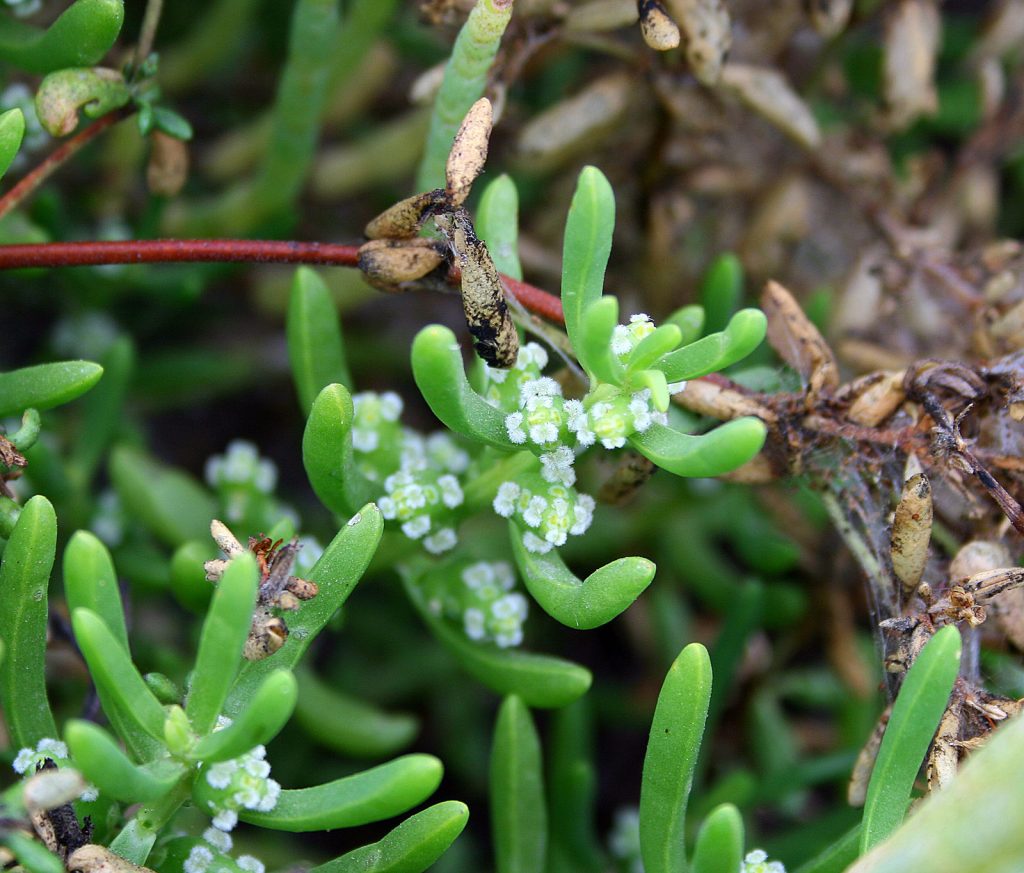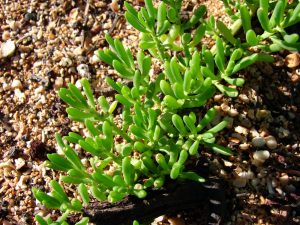
Batis maritima, preseasoned greens
Batis Maritima: Salt of the Earth
It has a dozen or more names, but no one is quite sure about its scientific name, Batis maritima, (BAT-is mar-IT-i-ma.)
Foragers call it saltwort, turtleweed, beachwort, pickle weed, smaphire, saimbhir, samapere (all mispronounced variations of St. Pierre) barilla, saladilla, lechuga de mar, planta de sal, virdrillo, vidrio, herbe-a-crabes, banana di rif, and akulikuli kai. They also eat it.
B. maritima is a common shore plant around most of the warm areas of the Americas, Hawaii and Australia. There are only two species in the genus, the one in the Americas and the one in Australia. It has been used as a pot herb, puree and pickle. Some folks call it a pre-salted salad, since it is a plant that can tolerate salt and retains some. It is not related to another plant called the Saltwort, Salsola. In some places B. maritima is considered endangered, in Hawaii it is a noxious weed.

Its seed oil might become a commercial product.
Ignored for centuries by the nutritional establishment, B. maritima has found some champions of late, not as a green per se but for its seed, which has an oil similar to safflower oil with antioxidants. It is also rich in protein plus the plant can tolerate salty ground so it is a potential crop on land that is now fallow by salt content. Saltwort also has a good amount of starch which seems to be of a small size suitable for, in the words of the researchers: “food thickeners, paper coatings, laundry starch, dusting powders, cosmetics, fat replacers, thickeners in the printing of textiles and biodegradable plastics. “ Yum. The ashes of the plant were also used once in make soap. Double yum.
As to why it is called Batis maritima… Maritima means growing near the sea and as is often the case, there isn’t much debate over what the species name is, but rather the genus. Batis is from ancient Greek, it was the name of a couple of women in mythology. It was also the name of some seaside Greek plant Pliny mentioned. It is presumed Latin Batis was rendered from Latin Batus, which means blackberry. That was stolen as usual from the Greek word Batos, also meaning blackberry, sometimes bramble. The next question is why blackberry? Well, as some people call it the “reef banana” referring to the shape of the small leaves, the fruit of the plant resembles blackberries somewhat, like the leaves bananas. Mystery maybe solved.
The only mystery I have about the plant is some references call it strongly scented, some mention no scent at all. I’ve never detected much of a scent. I can’t explain the discrepancy. One more thing, B. Maritima is also the favored food of large marine iguanas on the Galopagos Islands.
Green Deane’s “Itemized” Plant Profile
IDENTIFICATION: Evergreen, low shrub, six to 24 inches tall, flat growing where colonizing new mud, once rooted, grows bushy. Leaves small, swollen, fleshy and narrowly club-shaped, can look like little bananas, bright green, but can also be reddish, flowers small, on spikes, flowering from mid summer to fall.
TIME OF YEAR: Year round, flowers in summer and fall.
ENVIRONMENT: Salty environments, mud flats that are not flooded always, shoreline, common among mangroves.
METHOD OF PREPARATION: Leaves raw or cooked, potherb, puree, pickles; pepper-corn size seeds edible in salads, toasted, or “popped” like corn. Roots chewed like sugarcane, boiled for a beverage. One report says leaves can be toxic in larger amounts. Boiling leaves twice reduces their salinity.


My current interest in this is for gardening rather than foraging. (Basically I am looking for edible stuff that can survive container culture on top of a huge, full sun concrete slab [ie reflected heat] & believe desert plants & halophytes to be the top contenders. ) I may end up using whatever I can find/buy first, but do you have an opinion about the comparative culinary merits of Batis maritima vs. Salicornia vs. Suaeda linearis? (Salsola soda, being a winter annual, is in a different cultivation niche.) One of the beneficiaries/consumers happens to be a “supertaster” (I.e. is sensitive to and hates bitter vegetables and cabbage) . I think annual iceplant is likely to be the best bland/bulk salad green, but think there may be a case for a steamed etc saltwort for variety. Thanks. (FL panhandle, z8b)